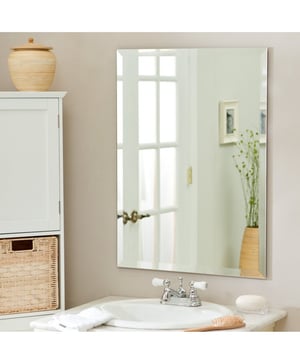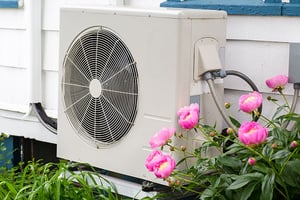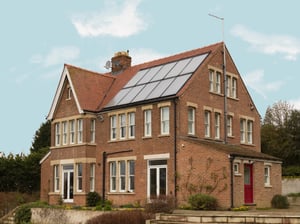
District heating schemes use a single powerplant to provide heating and hot water to many buildings. They have been promoted as important in decarbonising the British...
So you’re embarking on a new adventure? All of your ducks are in a row; career, partner, kids. It’s time to tick that next box – build your own home. The years of dreaming and scheming have finally paid off and here you stand on the threshold of… of what? How will you approach this mammoth task and what, if anything, will you do differently?
One of the major decisions you will have to make is about heating. An expensive undertaking to both install and maintain and almost impossible to correct if you don’t choose carefully from the start. Mains gas is the cheapest way to heat your home, isn't it? But what if you don’t have access to mains gas? Or a house with no gas supply? What is the most efficient heating system? What are some of the alternative heating methods for homes?
The good news is there are many viable options. The bad news: this isn’t a one size fits all scenario. Each system has its own benefits and pitfalls for you, your family and the environment. To make a truly informed decision, your first step should be to have a clear understanding of your property’s thermal performance, which means understanding the room by room heat loss on a cold day in winter (for more on this see our article on SAP and thermal modelling). With this critical calculation in hand it is possible to match different heating systems to the thermal performance of the building. The correctly specified system should have the lowest installation and running costs and keep your home comfy for years to come.
Let’s look at some options involving electricity, heat pumps, oil, biomass and even solar;
 If you are building a new build then your heat loss will be minimal and the responsiveness of the heating system becomes the most important factor to consider. This is because the rooms need so little energy to heat them small changes such as several people entering the room or the sun coming out can be enough to overheat the space. What you’re looking for is a system where the heating emitter (i.e. radiator) has a low thermal mass as this equates to more responsive heating to maintain a comfortable room temperature. Consequently infrared, direct electrical or fan assisted radiators are not only going to be the most comfortable option but with the correct controls will be the cheapest to install and to run.
If you are building a new build then your heat loss will be minimal and the responsiveness of the heating system becomes the most important factor to consider. This is because the rooms need so little energy to heat them small changes such as several people entering the room or the sun coming out can be enough to overheat the space. What you’re looking for is a system where the heating emitter (i.e. radiator) has a low thermal mass as this equates to more responsive heating to maintain a comfortable room temperature. Consequently infrared, direct electrical or fan assisted radiators are not only going to be the most comfortable option but with the correct controls will be the cheapest to install and to run.
Heat pumps are complex pieces of equipment to specify but the technology is pretty conventional. They work on a similar principle to a fridge or freezer, but instead of taking the heat from inside and dumping it externally, a ground source or air source heat pump extracts the heat from the outside air or the ground and pumps it into your home. They are at maximum efficiency when there is only a small difference between the heat source and the target room, meaning the typical flow temperature of a heat pump system is around 40°C (a traditional boiler is 75°C). In order to compensate for less heat from the source, larger emitters are needed and usually take the form of underfloor heating and on occasion oversized radiators. As the energy from a heat pump is relatively low compared to boilers, the building needs to be significantly better insulated. Unfortunately, too often heat pumps are installed in buildings which are not sufficiently insulated and this leads to run away electricity bills (and emissions).

As heat pumps are less efficient when the temperature differential rises they are not suited to providing hot water [read more here; Heat pumps for heating - pros and cons]. This is important because as buildings become better insulated the proportion of energy used for space heating declines and proportionally more energy is used for hot water (3 times as much is common). Before deciding on a heat pump real thought needs to go into the thermal performance of the building, the likely occupancy and lifestyle of the occupants.
For buildings with poor thermal performance which really means any building built before this century, then it is likely the amount of heat loss in each room will be too large to economically heat with a heat pump or through direct electrical. You’ll need to be looking at a system with substantial high flow temperatures. The considerations affecting the exact choice of boiler are beyond the scope of this article but really need to be investigated thoroughly for both capital and running costs as well as the practicalities of managing and maintaining the system. All of these systems require the storage of energy on-site so don’t forget about access for regular deliveries.
Dare to be different - for a low energy building in a rural setting consider a wood burning stove and solar thermal (ie hot water) panels. A typical 3 or 4 bedroom low energy house is likely to only need 2 or 3 kW of heat for the whole building in the middle of winter. A wood burning stove is likely to produce something like 6 to 12 kW of heat, almost three times your requirements. The majority of this energy is collected by a back boiler, stored in thermal stores and for both hot water and space heating. Radiators strategically positioned in the hallways and landings can distribute the heat throughout the building.
 When it’s too warm for a cosy fire, the solar thermal panels will provide enough hot water even in the UK. These collaborating systems are highly efficient and can have an electrical backup so are very robust as well as being relatively cheap to install and run. Of course, having a free wood supply at the back of your house doesn’t hurt!
When it’s too warm for a cosy fire, the solar thermal panels will provide enough hot water even in the UK. These collaborating systems are highly efficient and can have an electrical backup so are very robust as well as being relatively cheap to install and run. Of course, having a free wood supply at the back of your house doesn’t hurt!
The 2 main points to remember when choosing any heating system is to really understand the thermal performance of the building and likely occupancy. A retired couple who stay at home will be very different from a young family where everyone is out during the day. So when you are relaxing in your newly completed home, built with your own hands, or at the very least your own imagination and drive, you will actually be relaxing with a perfectly controlled climate - by design!
To find out more about heating a eco home, click here.

District heating schemes use a single powerplant to provide heating and hot water to many buildings. They have been promoted as important in decarbonising the British...